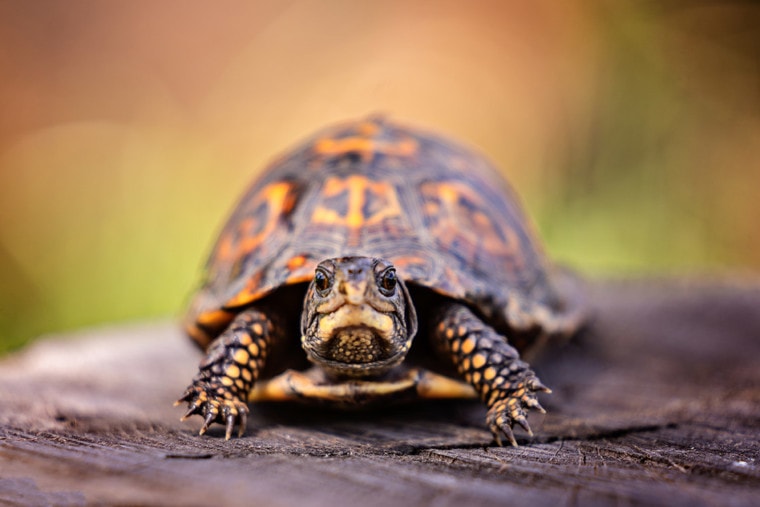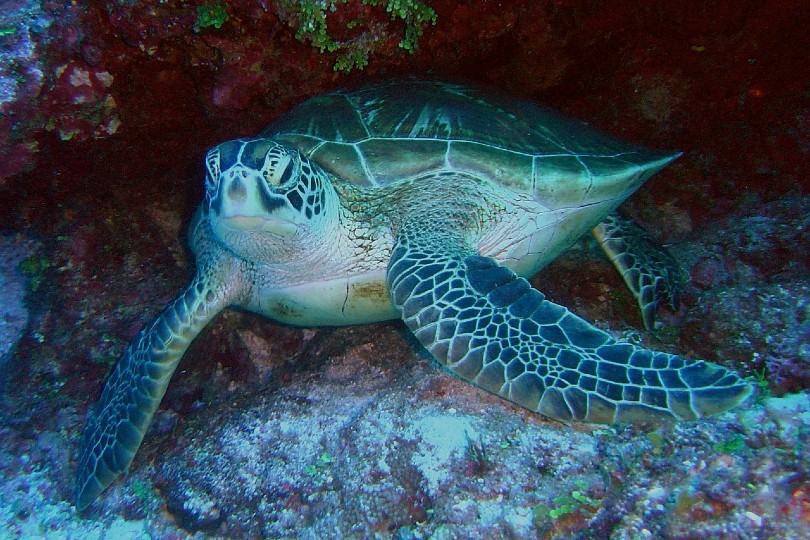
In the winter, you probably notice a distinct lack of turtles. After all, these cold-blooded reptiles have no way to generate their own heat. When it’s cold outside, they’re also cold.
But most turtles live for years. Where do they go in these colder months?
Most turtles brumate, though exactly where depends on the species. Most freshwater turtles retreat underneath the water, where temperatures remain more stable throughout the long winter months. They may bury themselves in the mud at the bottom of the lake, where they remain until it warms up again.
As you might know, though, turtles breathe air, not water. How do they survive months underwater?
How Turtles Breathe While Brumating
Turtle brumation is a bit complicated. These animals were designed to breathe fresh air, making brumating for months underwater a bit complex.
However, the turtle has a unique ability called “cloacal respiration.” In other words, they breathe through their butt. The exact opening that they pass waste and eggs out of is also rich with blood vessels. Gas exchange can take place across these blood vessels.
When turtles are brumating, their oxygen needs are meager. They have minimal energy needs because their temperature will match the water temperature outside. The oxygen in the water is usually plenty to provide for their needs until spring.
However, turtles still occasionally run into the problem of too little oxygen. Typically, this occurs when the water isn’t oxygenated enough to provide the turtle with their needs.
Luckily, turtles can switch to anaerobic respiration, which doesn’t require any oxygen at all. But this causes a buildup of lactic acid, prompting the turtle to spend more time sun-bathing in the spring. This method isn’t the best option, but it can help turtles survive when their oxygen needs aren’t being met.
Some turtles use the same spot year after year, while others will switch. We don’t exactly know why turtles choose certain spots over others.

How Long Does a Turtle Brumate?
Turtles brumate according to the temperature of the water they’re in. Therefore, how long they brumate will depend on their location. Those in the north will spend more time brumating than those in the south.
The length will also vary by year. Spring doesn’t precisely occur on the same day every year. Therefore, turtles will stay in brumation for different lengths as well.
Most turtles can brumate a maximum of 8 months a year. Many won’t spend this long brumating, though.
- Related Read: Reptile Brumation & Dormancy: What You Need to Know
Can Turtles Survive in Snow?
By the time it snows, most turtles are far underneath the water. They’re protected from the elements there.
Due to the cold temperatures, turtles will have an extremely slow metabolism. They will spend most of their time lying on the bottom of the pond. You may occasionally see them swimming around underneath the water, though.
Most of them will not come up to the surface. The water temperature is much more stable than the air temperature and enables the turtle to survive easier.
If you see a turtle in the snow, don’t panic — they probably know what they’re doing. However, this is a rare sighting indeed.
Of course, if you own a pet turtle, please do not put them in the snow. Pet turtles don’t prepare for the coming winter like wild turtles. They don’t experience the change in lighting and temperature that wild turtles do.
Therefore, they are far less able to withstand these colder temperatures.
- See Also: How Intelligent Are Turtles?
Where Do Snapping Turtles Live in the Winter?
Snapping turtles do what every other type of freshwater turtle does: They brumate.
However, this species is a bit complicated. Not all of them brumate. Some remain active underneath the ice all winter long.
In some cold climates, hatchlings may brumate in the nest over winter.
The snapping turtle is remarkably tolerant to the cold, unlike some other species. They seem to have a far easier time getting through the winter — so much so that some individuals may not brumate at all.
More About Snapping Turtles:
- Are Snapping Turtles Dangerous? What You Need to Know!
- What Do Baby Snapping Turtles Eat in the Wild and as Pets?
- Do Snapping Turtles Make Great Pets? What You Need to Know!

Hibernation vs. Brumation
Hibernation and brumation are a bit different. Mammals hibernate, while reptiles brumate.
Brumation is similar to hibernation. The main difference is the types of animals that each term is used with. Reptiles can’t hibernate because that’s only something that mammals do. However, they can brumate.
The main difference is the animal’s body temperature. Warm-blooded mammals still need to make body heat during hibernation, which uses up more calories and requires different body processes.
Cold-blooded animals don’t make body heat at all. Instead, their temperature matches the temperature of their surrounding environment.
Most animals that go through brumation will wake up when the weather warms, not necessarily in the springtime. You may notice a turtle sunning themselves on a warmer-than-average December day, for instance.
Turtles don’t keep up with the time. They keep up with the temperature. When it gets warmer, their metabolic rate increases and they “wake up.” This differs from most species that hibernate, as they usually hibernate for a set period.
It is also relatively easy to wake up brumating animals because they’re just remaining still, not sleeping. Hibernating animals are difficult to wake up. Typically, they remain sleeping even if they are disturbed.
Brumating animals will also move around to find food and water — hibernating animals won’t. It isn’t unusual to find a turtle out wandering around during the winter on warmer days. Mammals will not walk around while hibernating, though.
How Do Turtles Know When to Wake Up?
Turtles don’t sleep like hibernating mammals. Instead, the cold water causes their metabolism to slow down substantially. With such a slow metabolism, the turtle doesn’t have much energy and starts to slow down.
Therefore, they don’t sleep, so they don’t need to know when to wake up.
Instead, whenever the water starts to warm up, the turtle’s metabolism increases. This extra energy makes the turtle more active.
They may wake up during the middle of winter on warmer days. It isn’t odd to see some species swimming around underwater for much of winter, though they will move slower and less often than during the warmer months.
If it happens to cool down again, the turtle will slow down.
Once it becomes spring, the weather won’t get cold again. Therefore, the turtle’s metabolism won’t slow down, and they’ll stay active.
It isn’t that the turtle decides that it is spring and continues about their business. Instead, the temperature has a direct effect on their activity level. When it’s cold, they’ll be less active. When it’s warm, they will be more active.
Do Turtles Need to Sun After Winter?
Many turtles will sun more after the winter months. However, not all individuals will need to sun more than usual.
All turtles need to sun throughout the warmer months, especially in the morning. They are cold-blooded animals, so they need the heat from the sun to start their metabolism.
After winter, they will need to warm up to function correctly. If they can, many turtles will attempt to warm up in the spring. Sunning in the spring may take longer than in the summer because the overall temperature is lower. It takes them longer to warm up.
If they experienced low oxygen levels over the winter, they might have a buildup of lactic acid. This can be neutralized through the turtle’s shell with UV rays. Therefore, many turtles may spend extra time in the sun to help clear their bodies of this toxin.
Final Thoughts
Turtles spend the winter months underneath a pond or lake, usually buried in the mud at the bottom for protection.
While turtles do slow down substantially in the winter, they don’t truly hibernate. Instead, the lower temperatures make their metabolism slow down, which slows down the turtle. They may still move on warmer days. Some species even stay active throughout the winter.
This process is called brumation, as opposed to hibernation.
Turtles can stay underwater for extended times over the winter due to their decreased metabolic rate. With such a low metabolic rate, these turtles don’t need much oxygen. They exchange a small number of gasses through the same orifice that they use for egg-laying.
Usually, this is enough. Turtles also have the option to function without oxygen. However, this will result in higher amounts of lactic acid, which the turtles will need UV rays to get rid of in the spring. Lactic acid is the same substance that causes muscles to become sore after a hard workout, so you can imagine how the turtle may feel!
Their ability to survive the winter is a significant reason that many turtles live so long. Their metabolic rate slows down, causing their aging to slow down as well.
- Next on your reading list: Do Turtles Shed?
Featured Image Credit: Luiza Kleina, Shutterstock







